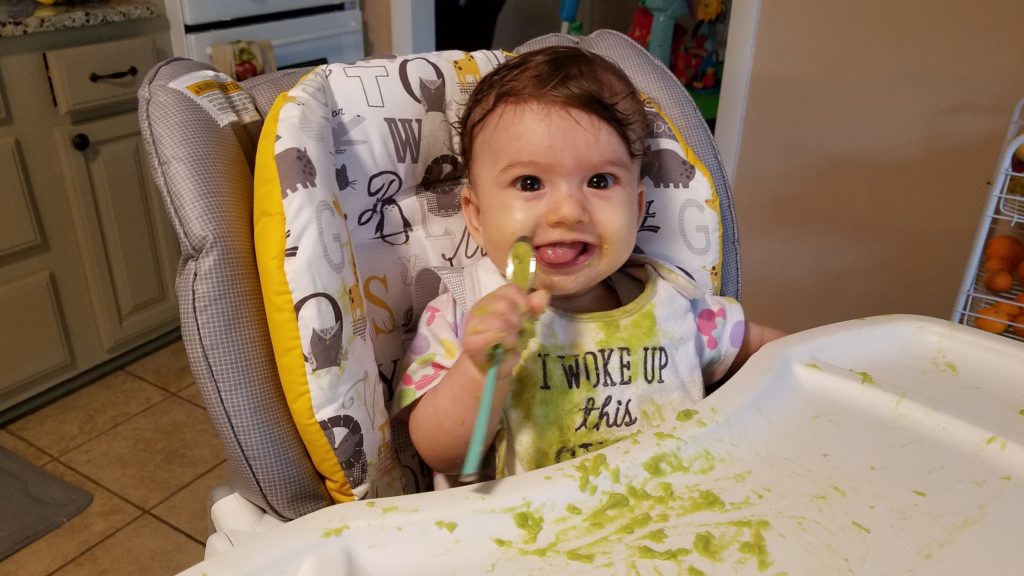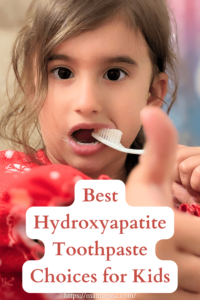Your cart is currently empty!
How to Start Solids With Your Baby – The Easy Way!
I’m all about doing things the easy way. Maybe that is why I chose to go the baby-led-weaning route when I was googling how to start solids with my baby. But figuring out how to start solids might feel anything but easy to you right now, Mama.
I know how daunting it is trying to figure out how to start solids with a miniature human whose digestive system has only ever known liquids. You are probably feeling a little nervous and asking a lot of questions.

How do I know when he’s ready? What do I feed him first? How much should I feed him? What if he chokes?
These are all valid and normal questions, and let me start off by encouraging you to ask your child’s doctor about how to start solids along with doing your own research.
I am not a medical professional. Nothing in this post should be construed as medical advice. This is simply the advice of a mom who has been there.
And having come out on the other side of starting solids, I can assure you that all the unknowns of the solid food world that might seem scary right now will likely culminate in a happy, picky-eating toddler no matter what you do!
Hey Mama, if you find my blog posts helpful, would you help support this blog by making purchases through product links on this page? It will not cost you any extra but the commissions I receive as an Amazon and brand affiliate help to cover the costs of operating this blog so that I can keep it running ad-free. Thank you so much for your support. You are literally the reason this blog was started and the fuel that motivates me to keep it going!
DISCLAIMER: Please note that I am not a medical professional and nothing in this post should be taken as medical advice. Please speak with your baby’s pediatrician about starting solids or any concerns you have.
Table of Contents
- Knowing it’s Time to Start Solids
- Choosing First Foods
- How I Fed My Baby Solids
- How Often and When to Feed Solids
- This is My Easy Way to Start Solids
Knowing it’s Time to Start Solids
How can you know your baby is ready for solids?
There are a few key indicators of solids readiness and once you know them and discuss any uncertainties with your baby’s doctor, the easiest way to know it’s time is simply by watching your baby and trusting your gut.

Let’s go over the major things to consider while you contemplate how to start solids with your baby.
First of all, there is a general rule that introduction of solids should begin between 4 and 6 months. According to Mayo Clinic, the reason for starting solid food at this particular age is because this is when babies begin to be physically capable of keeping food in their mouth and swallowing it.
However, according to Kelly Mom, solids should not be started before 6 months old due to the underdeveloped digestive systems of young babies.
She further notes that there is no need to worry even if your baby is not interested in solid food during most of her first year of life as long as baby is growing and thriving on breast milk (or formula).
So let’s say your baby is nearing 6 months old and you’re wondering what signs of food readiness to look for. Here are the main things your baby will be doing when she’s ready to start solids:
- Sitting up
- Controlling head movement steadily
- Noticing food you are eating
There are a few things to note about each of these food-readiness indicators.
Sitting Up
Some sources say sitting up with support is a sufficient sign of readiness while others state that sitting without support shows adequate development of the trunk and digestive region to warrant eating solid food.
I was concerned about this as my daughter neared six months old and still was not sitting up on her own, despite the fact that she had been holding herself erect in my arms from 6 weeks old and was beginning to practice crawling on hands and knees at 6 months.
When I brought it up to her pediatrician, he said sitting with support was a reliable enough sign that she could start solids, so we did. Since starting solids with her went so well, I feel this was a good decision.

But, because there are different opinions on this, ask your own pediatrician and do your own research on the topic if your little one is not yet sitting unassisted.
Controlling Head Movement
Even if your baby is not sitting up without assistance yet, she should at least be able to control her head movement well before solids get anywhere near her mouth so that she can swallow appropriately and not choke.
For more on preventing and responding to choking in young children, read this post.
Noticing Your Food
This is a pretty obvious sign that your baby is interested in trying out big-people food. I’ve heard stories of babies actually salivating with excitement while watching mommy and daddy eat.
My own daughter began to watch me with great interest as I ate my food when she was almost six months old. It was a noticeable change from her complete ignorance of food prior to that point.
Choosing First Foods
Okay, the time has come and you know your baby is ready. But you are still wondering how to start solids.
First of all, you need to figure out what foods you’re going to start with and go grocery shopping.

There are some who claim you must start with veggies instead of fruits to avoid giving your baby a sweet tooth. However, keep in mind that breast milk and formula already have a lot of sugar in them, so baby is already used to filling up on healthy sweets.
I tried to start with mostly veggies just in case, but I honestly believe the overall family diet baby grows up eating is a whole lot more important for creating a healthy eater than which food she tastes first.
If you want to start off easy like I prefer to do, go with avocado or banana. If you plan to “make” your own baby food, it doesn’t get any easier than fork-mashing very ripe produce.
For more detailed information on how I prepared food for my baby, get my FREE guide on how to make baby food by entering your email at the bottom of the page!

As long as your baby’s doctor gives the okay, you can also start with other types of food besides fruits and veggies as long as it’s something you can cook to be extremely soft and mashable and/or you are able to puree it.
That really is the basic rule for what to feed your baby for first foods: Anything that is soft enough to be mashable with gums or pureed into a pretty smooth texture.
I only did fruits and veggies for the first few months of starting solids because those are the foods I value the most in terms of nutrition. Unfortunately, they are also the foods I struggle to eat enough of and am probably lacking in my breastmilk more than any other nutrients.
What to Do About Allergenic Foods
For what to avoid, be sure to check your family’s allergy history. Any known allergens should be avoided until baby is older in case of a severe adverse reaction.

However, as long as there aren’t any known familial allergies to common allergenic foods, the current research suggests introducing things like peanuts and eggs early may help reduce the chances of your baby developing an allergy.
Be sure to check with the doctor before attempting to introduce any allergenic food.
And, obviously, foods that are a choking hazard like peanuts need to be modified to be safe for infants (for example, mix a very small amount of creamy, natural, no added sugar or salt peanut butter into some cooked or pureed apples, pears or bananas).
It’s also recommended that you wait 3-4 days before introducing each new food in case of a delayed allergic reaction to something. This way, if your baby develops a rash or has digestive issues with a certain food, it will be easier to know which food caused it.
I had a friend tell me that some foods can even cause a delayed allergic reaction up to a week later, as was the case with her children who had many allergies and digestive struggles. If you have a baby with reflux or other digestive issues, you may want to begin by spacing out new foods by a week or more.
How I Fed My Baby Solids
So the big day has arrived! It’s time for your baby’s first meal. Get your camera ready! But you’re probably asking once again how to start solids with your baby.
Like I said, I’m all about easy. And I’m also all about letting my daughter make her own decisions about how to meet her needs. So I went with a hands-off approach to introducing solids.
I put my daughter in her highchair, mashed up some avocado, put it on her tray with a baby spoon and stepped back.

You never know what’s going to happen at this point, but in my daughter’s case, she LOVED her first taste of something other than Mommy’s milk (obsessed with it though she was). And she did pretty good getting it into her mouth (these soft-tip baby spoons are great for letting your little one self-feed safely).
From the first day on, I never sat down with a bowl of food in my hand, out of her reach, to shovel in as much as I could get her to swallow.
I would help her when she was clearly struggling to get enough food in her mouth. I did spoon-feed her at times when she seemed to need help, but I always simultaneously allowed her access to the food to touch it, play with it and practice getting it into her mouth.
The Inevitable Mess
Obviously, you can’t be afraid of the inevitable mess if you go this route.
When I was reading up on how to start solids, I came across the suggestion of putting plastic garbage bags under the highchair for easier cleanup. That just sounded ridiculously wasteful to me and it would not have actually saved much cleanup time.
My recommendation to you would be to invest your efforts into finding a good highchair that has as few cracks and crevices as possible. That is where the majority of your cleanup nightmare will happen (that and the cracks and crevices of your baby – for that mess, I recommend these supper soft washcloths).
Unfortunately, my highchair has a lot of places for small food particles to get stuck and it’s nearly impossible to clean them out. Eventually, it gets smelly and the only way to save it from the dumpster is to take a power washer to it.
Why This is Still the Easy Way to Start Solids
Now, the extra cleanup after feeding your baby may not sound exciting, but how does a more relaxed mealtime for mama sound? You might actually get to eat for a change while your baby practices getting food into his own mouth!

This is where the easy part comes in. I loved that I could put some food in front of my baby, and then have my hands free to feed myself – something that was a new experience for me after 6 months of 24/7 breastfeeding!
The other thing that is made easier with this method of starting solids is figuring out how much food your baby needs. With food in front of him that he can eat at his own pace, your baby will be allowed to decide for himself when he’s done.
How Often and When to Feed Solids
Deciding how often to offer solid food to your baby may be another confusing question swirling around in your mind as you figure out how to start solids.
In my daughter’s case, I planned to start with one meal and gradually work up to three over the course of a month or two. However, when she took to solids so well, we instantly went to two meals a day most days.
Remember that in the beginning stages of starting solids for the average healthy baby, it’s about getting him used to big people food rather than meeting a nutritional deficiency. Don’t worry about trying to get a certain amount of meals in by a certain age.
I have heard many accounts of babies who’s primary (or even only) nutrition at one year of age is still breastmilk. This is not an unusual situation for reflux baby mamas in particular to find themselves in.
Just remember that your baby’s health should always be measured by how well he is meeting developmental and growth milestones (based off of family characteristics – not other people’s babies) rather than his caloric intake or nutritional preferences.

Similarly, the question of when to feed your baby can be confusing. You may have read that offering solids too soon after a milk feeding will result in your baby not eating. On the other hand, giving solids when baby is too hungry could result in frustration due to not getting enough food in his mouth to satisfy his hunger.
In my daughter’s case, she nursed so frequently to sooth her infant reflux that I just worked in a solid meal whenever it was convenient.
You know your baby best, and after some experimentation, you will be able to figure out when the best times are to feed him solids. Just start off trying meals during a time when you know your baby isn’t going to be starving sometime within the next 30-45 minutes (meals with little humans new to the world of solid food can take a while).
I personally am not a fan of super strict schedules and my baby wasn’t either, so we were pretty relaxed about when we had solid meals, and she turned out to be a pretty good eater!
This is My Easy Way to Start Solids
I recognize that my idea of easy may not look the same as it does for another mama (and that’s totally fine! Motherhood isn’t a competition). You may not care or have time to make your own baby food or you may not be interested in the extra mess of letting your baby experiement with feeding himself yet.
But the reason I feel this is the easy route for starting solids with a baby is because I got to eat my own food in peace while she decided what and how much to eat. And ultimately, this was the easiest and most relaxing way to share meals.

If you found this post helpful, be sure to share it with other mamas learning how to start solids with their babies via the social share buttons below. And if you have any advice about the world of solids, please share it in the comments!












Leave a Reply